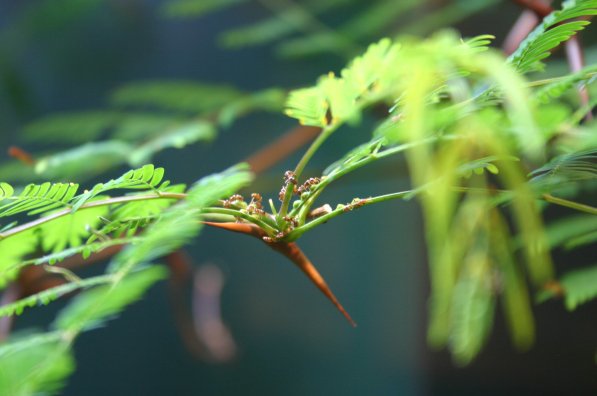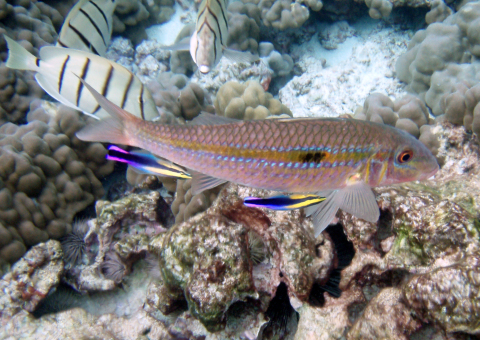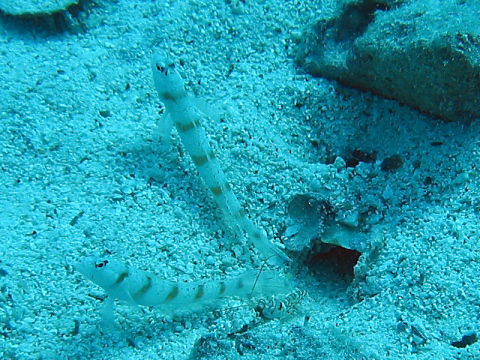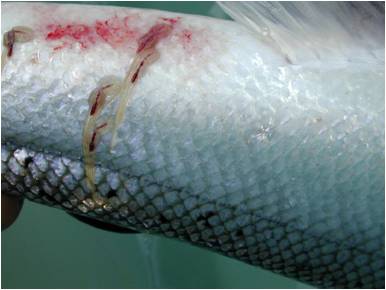18.4: Symbiotic Relationships in Coral Reef Ecosystem
- Page ID
- 13079
Coral reefs are home for many organisms such as sponges, fish including large nurse sharks and reef sharks to groupers, clownfish, eels, snappers, and parrotfish, jellyfish, anemones, crustaceans, other invertebrates and algae. So, how do coral reefs support such a huge weight on their shoulders? It is the symbiotic relationship that is formed when two different species interact with each other. These interactions create a balance within the ecosystem because at least one of the species is gaining from it. The other species may also gain from the relationship, be unaffected or even get harmed from the relationship. Symbiotic relationships are very common in the ocean, especially near coral reefs. There are three main types of symbiotic relationships. They are mutualism, parasitism, and commensalism. Mimicry is also frequently seen amongst coral reef organisms.
Types of Mutualism:
There are two primary types of mutualism: obligate mutualism and facultative mutualism.
Mutualism, or a mutualistic relationship, by definition, is when two organisms of different species work together so that each is benefiting from the relationship.
- Obligate mutualism is when neither organism can live without one another.
An example of obligate mutualism is the relationship between ants and Acacia plants. While the plant provides shelter and food for the ants, the ants actually defend the plant from organisms such as other herbivores that may eat the plant, as well as remove any other species of plants that may limit the plant’s growth.
A more specific example of obligate mutualism that is more related to this topic would be the relationship between hard coral and algae (zooxanthellae). The relationship between coral and zooxanthellae (algae), is one of the most important mutualistic relationships within the coral reef ecosystem. Zooxanthellae are microscopic, photosynthetic algae that reside inside the coral. The hard coral provides protection, as well as compounds needed for photosynthesis to occur. In return for their protection for herbivores and other organisms, zooxanthellae photosynthesize organic compounds from the sun, and then pass the nutrients, glucose, glycerol, and amino acids, which are the products of photosynthesis, to their coral hosts, essentially giving the coral reefs their beautiful colors. The corals then use those nutrients to produce proteins, fats, carbohydrates, and calcium carbonate. This is so important, in fact, approximately 90% of the nutrients produced during the photosynthesis in zooxanthellae is transferred to the coral for their use. Zooxanthellae also aid in the excretion, or removal of waste such as carbon dioxide and nitrogen. Ultimately, without algae, coral would starve to death (coral bleaching), and if algae didn’t have protection, they would be more vulnerable to several herbivores and other organisms. This relationship is so important, that if this mutualistic relationship did not exist, it would be very likely coral reefs would not even exist. Therefore, making this relationship obligate mutualism, as mentioned before.
 “
CORAL POLYP
” BY EMAZE
“
CORAL POLYP
” BY EMAZE
The mutualistic relationship between anemones and clownfish is also another commonly known relationship. Clownfish are found in warmer waters of the Indian and Pacific oceans. Of the over 1,000 anemone species that live in the ocean, only 10 species coexists with the 26 species of tropical clownfish. Within these species, only select pairs of anemone and clownfish are compatible. Sea anemones are actually predators, with stinging polyps, that attach themselves to rocks, the ocean floor, or even coral. They patiently wait for fish to swim by close enough to get entangled in their poisonous tentacles. The toxins paralyze their prey, and the tentacles guide the prey into the anemone’s mouth. However, clownfish are the exception and actually call the anemone home. Clownfish are coated with a mucus layer that essentially makes them immune to the deadly sting of the anemone. Therefore, clownfish are able to live within the anemone’s tentacles, while also gaining protection from predators, and the clownfish helps feed the anemone by either letting them eat their leftovers, or by also luring fish over to the anemone, so that the anemone can catch them with their poisonous tentacles, and eat them for dinner (or maybe lunch).

“Clownfish and Sea Anemone” by Samuel Chow under Flickr
- Facultative mutualism the other type of mutualism, is when species benefit from one another, but do not necessarily fully depend on one another.
An example of facultative mutualism is the relationship between certain types of our gut bacteria, or the bacteria that live in our digestive tracts, and us humans. When we eat food, bacteria use some of the nutrients from that food we are actually digesting, and in return, they help us digest our food.
Again, a more specific example of facultative mutualism that is more so related to the coral reef ecosystem, is the relationship between shrimp or smaller fish and large marine organisms. The shrimp or cleaning fish remove materials, such as parasites, off of the larger marine organisms, in which they get a meal from, and the larger marine organisms have potentially harmful parasites removed!
As mentioned before, earlier on in the post, smaller fish or cleaner shrimp, such as the Bluehead Wrasse or Spanish Hogfish remove parasites and other materials off larger marine organisms such as fish, sharks, and rays. In most cases, these smaller fish would typically be the larger marine organism’s prey, however, in this case, these larger organisms gain the benefit of having these parasites removed, that could potentially cause harm, while the smaller fish or shrimp get a meal.
Cleaner fish and larger fish share a mutualistic relationship. This is because the cleaner fish eats harmful parasites and other small sources of food off of the large fish. This gives the cleaner fish a meal, the larger fish is helped because it no longer has these parasites on them. Often times larger fish wait in “cleaning stations” for the cleaner fish to come and get these things off of them. Some small shrimp can also be cleaners. The picture below shows a cleaner shrimp cleaning a large fish at a cleaning station that would normally eat the shrimp if it wasn’t for this mutualism.
 “DANGEROUS DINING” BY CHRIS LEWIS UNDER VIMEO
“DANGEROUS DINING” BY CHRIS LEWIS UNDER VIMEO
Another facultative mutualistic relationship is between the root-fouling sponge called Tedania inis, and red mangrove called Rhizophora mangle. In this relationship, the red mangrove provides the sponge with carbon that was produced by the mangrove, and the nitrogen the sponge releases gets eaten up by the mangrove to enhance growth.
Mutualism also occurs between spider crabs and algae. This relationship benefits both of these species because the greenish-brown algae live on the spiders back, which helps the spider crab blend into the shallow areas of the ocean floor where they live. In return, the algae benefit from a good place to live.
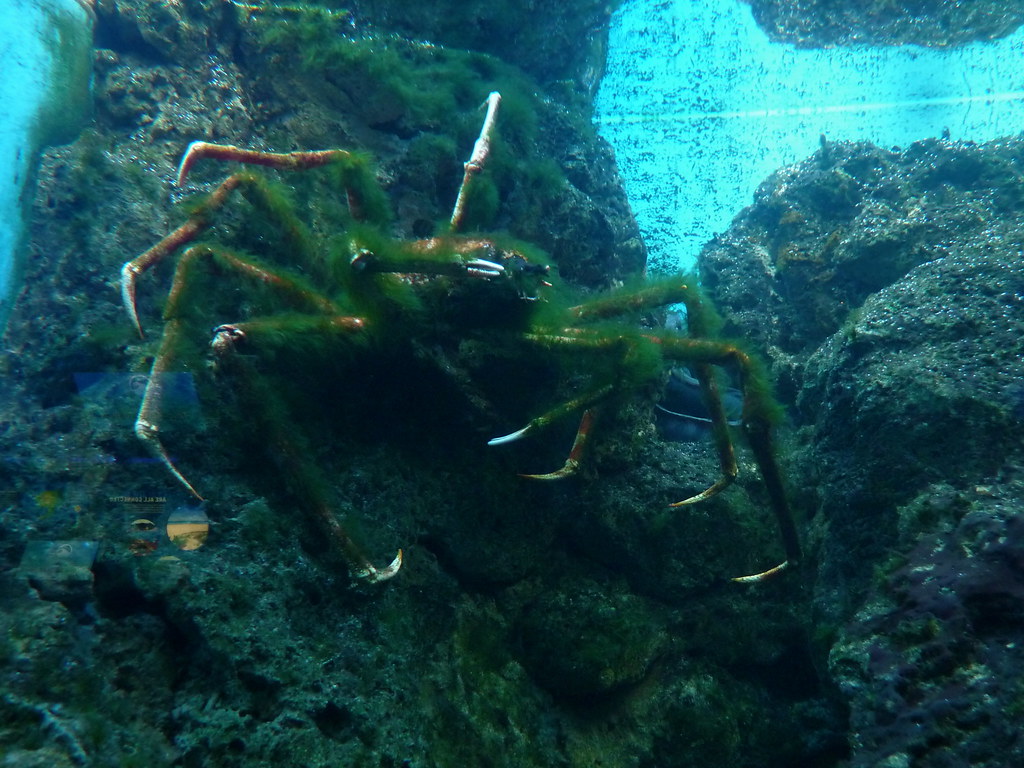 “JAPANESE SPIDER CRAB” BY (OVO) UNDER FLICKR
“JAPANESE SPIDER CRAB” BY (OVO) UNDER FLICKR
Another example is the relationship between the Boxer Crab and anemones. In this relationship, the Boxer Crab carries around two anemones that sting and it uses them for protection. The anemones are benefited because since the crab carries them around, it allows them to be mobile which increases their options for finding food.
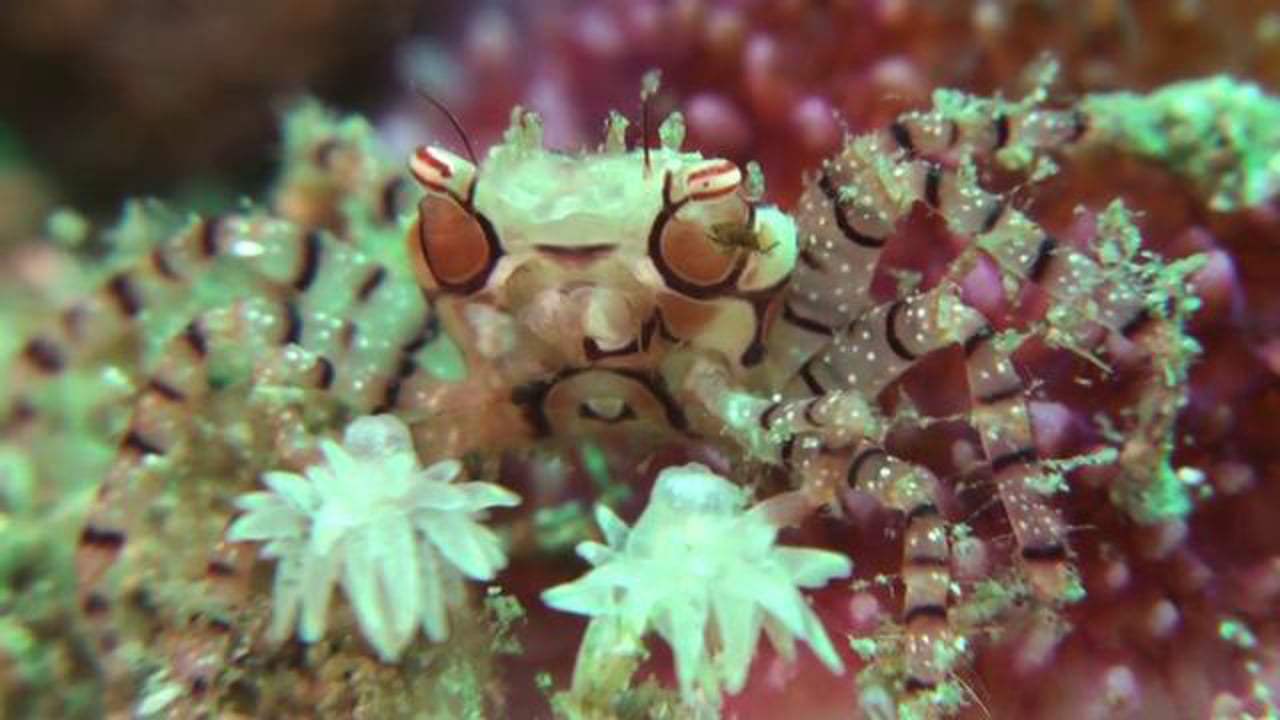 “BOXING (POM POM) CRAB” BY LIQUIDGURU UNDER VIMEO
“BOXING (POM POM) CRAB” BY LIQUIDGURU UNDER VIMEO
One last mutualistic relationship is the relationship between a goby (Nes Longus and Ctenogobius saepepallens) and a snapping shrimp (Alpheus floridanus). The shrimp dig a decent sized burrow in the floor of the ocean, and the goby will then live in the entrance of that burrow. When the shrimp exits the burrow, it will stay in contact with the goby through its antennae, and depending on the species of the goby, it will either signal to the shrimp of approaching predators by darting headfirst back into the burrow or by flicking its caudal tail. Ultimately, the goby gets a free place to live and hide from potential predators, while in return the shrimp gets a look-out individual while it hunts for food!
Parasitism:
Parasitism is not a mutualistic relationship because only one of the species is benefited. The parasite gains from the relationship while the other species involved is harmed. Ectoparasites live on the outside of the host body, whereas endoparasites live inside the host.
One example of a ectoparasitic relationship is between fish lice and small fish hosts. The fish can be killed if there are too many fish lice attached to it. The lice benefit from the fish by feeding off of their bodily fluids.
Isopods can also cause be involved in a parasitic relationship. Some isopods will eat the fishes tongue and then live in the fishes mouth so they can eat whatever the fish is attempting to eat.
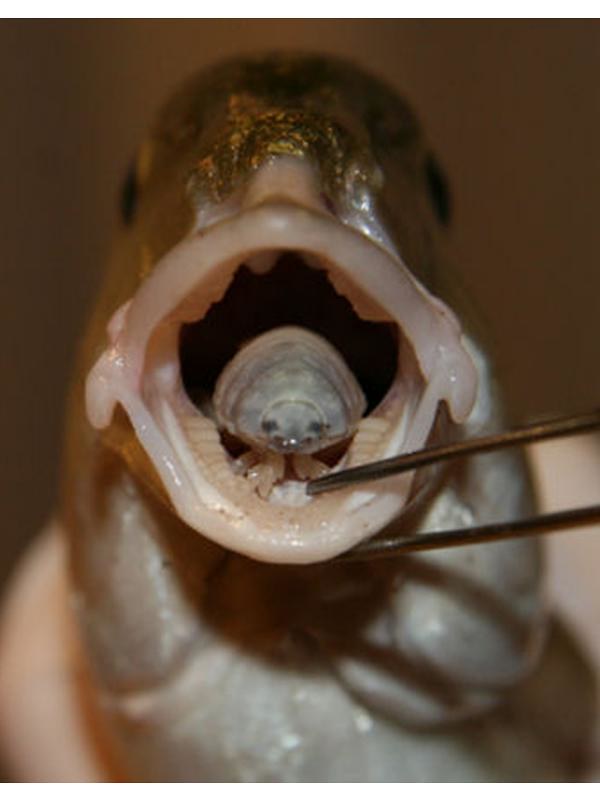 “BETTY IN MOUTH” BY UNIVERSITY OF SALFORD PRESS OFFICE UNDER FLICKR
“BETTY IN MOUTH” BY UNIVERSITY OF SALFORD PRESS OFFICE UNDER FLICKR
Commensalism:
Commensalism is a relationship where one species benefits from another species. The other species is neither harmed nor helped in this relationship. There are many examples of commensalism in the ocean.
One example of commensalism among marine life is jellyfish and small fish. The small fish will typically hide inside of the jellyfish’s stinging tentacles if the stinging does not affect them. The tentacles provide protection for the fish from larger predators. This relationship has no effect on the jellyfish.
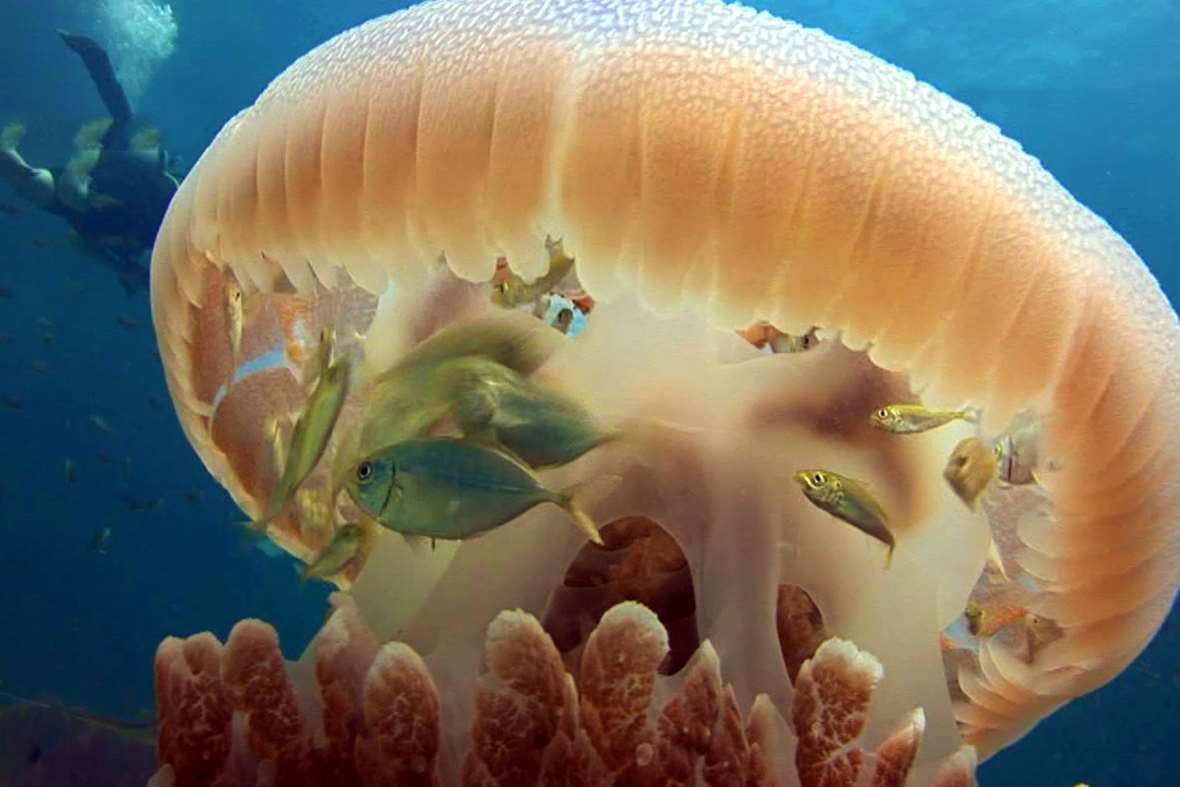
“BABY FISH TAKE SHELTER IN JELLYFISH” BY EARTH TOUCH NEWS NETWORK
Another relationship is between shrimp and a featherstar. The shrimp will blend in with the featherstar and use it for protection. As you can see in the picture below, it is very difficult to find the shrimp hiding in there.
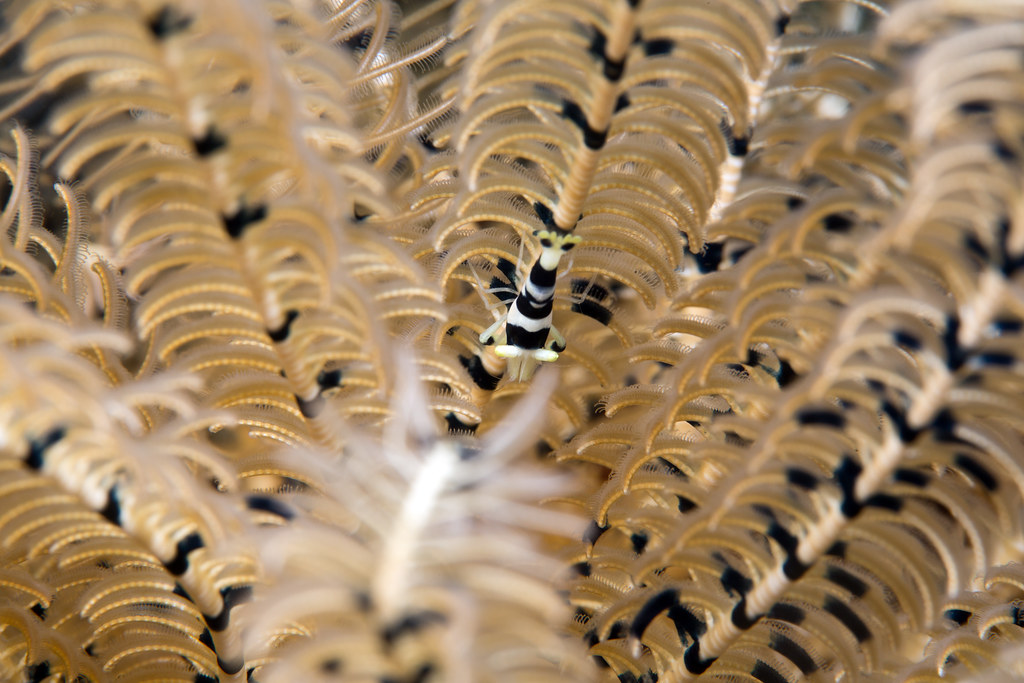
“Shrimp in Featherstar” by prilfish under Flickr
Mimicry:
One type of Mimicry is when one organism that is harmless evolves to look similar to another organism that is poisonous. This stops predators from eating them because they think they are the poisonous species. They can also use mimicry to appear larger than they really are.
The four-eye butterflyfish uses a large eyespot in order to appear larger to predators.
 “CHAETODON CAPISTRATUS1” BY CHRIS HUSS UNDER PUBLIC DOMAIN
“CHAETODON CAPISTRATUS1” BY CHRIS HUSS UNDER PUBLIC DOMAIN
Another example of mimicry is between the Sabre-tooth Blenny and Cleaner Wrasses. The Cleaner Wrasse have a mutualistic relationship with larger fish so they don’t get eaten, and the Sabre-tooth Blenny takes advantage of this relationship by evolving to look very similar to the Cleaner Wrasse. Instead of cleaning the larger fish, the Sabre-tooth Blenny will take a bite out the the large fish’s flesh and swim away. This is an example of aggressive mimicry.
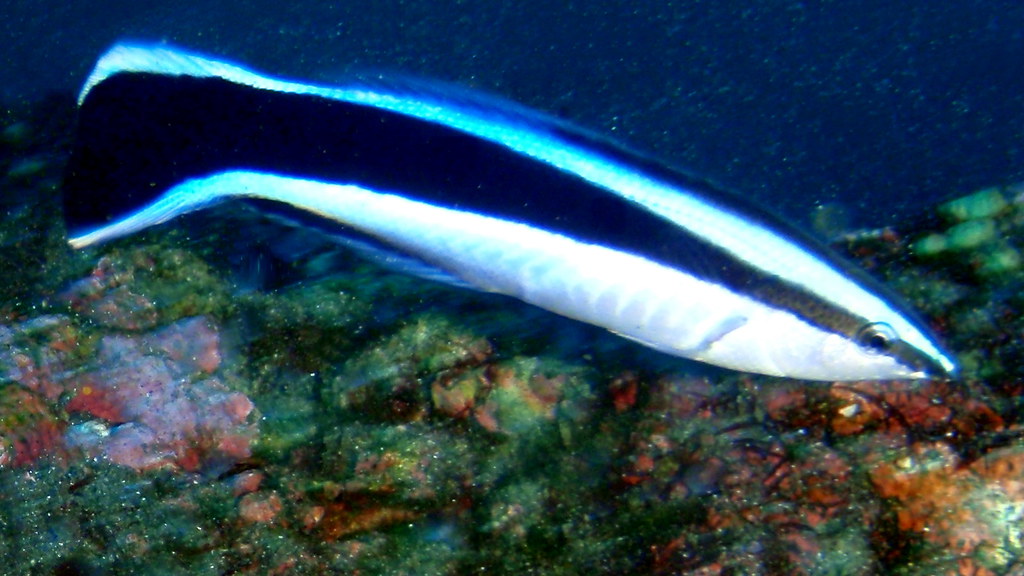
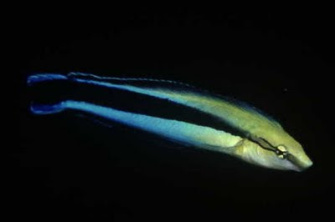
“BLUESTREAK CLEANER WRASSE” BY NEMO’S GREAT UNCLE UNDER FLICKR “SABRE-TOOTH BLENNY” BY FISH INDEX
On the top, there is a Bluestreak cleaner wrasse and on the bottom is a sabre-tooth blenny. You can see how similar they look and how fish could mistake them.
What’s the Big Deal?
Mutualistic relationships, whether obligate or facultative mutualism, are an integral part of sustaining a coral reef ecosystem, and without them, the coral reefs would simply not exist. These mutualistic relationships define a largely intricate number of connections and relationships which deeply rely on one other, and where one could start to deteriorate, another could as well. It is more important now than ever that we sustain healthy coral reefs to support these intricate relationships, communities, and ecosystems.
The information in this chapter is thanks to content contributions from Jaime Marsh, Christian Paparazzo, and Alana Olendorf


